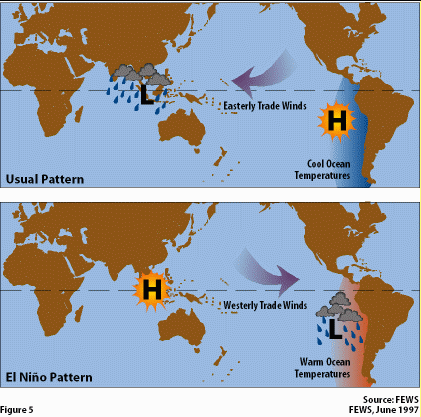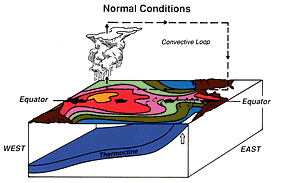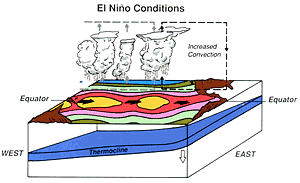
How does El Niņo Occur?
South-East Trades

http://www.reliefweb.int/w/map.nsf/wByCLatest/7D9E493C835C44EB85256A320051F863?Opendocument
The strengths of the prevailing winds over the equatorial Pacific, commonly known as the South East Trades depends upon the difference in surface atmospheric pressure between:
The subtropical high pressure region in the eastern Pacific -where cool, dry air converges and subsides; and
The low-pressure region over Indonesia-where warm air rises producing cumulonimbus clouds and heavy rain-fall.
During El Niņo, Indonesian low is weaker low than usual (i.e. have anomalously high pressure) moving eastwards into the Central Pacific, while on contrary the South Pacific becomes anomalously low.
 |
 |
these images were taken from http://www.earthinstitute.columbia.edu/about/aboutcase02.html without permission
The large width across the Pacific allows the existence of a huge pool of warm water in the west. Hence the Atlantic -with a shorter distance across the ocean- would have a much smaller warm pool. The Pacific warm pool is a gigantic source of heat that is one of the main controls on the atmosphere. When the warm pool shifts east (during El Niņo) or shrinks west (during La Niņa), the effects cause a disruption to the weathers associated with this cycle. In the Atlantic the warm pool does not have enough energy relative to the Pacific warm pool to make a difference to worldwide weather.
Proxy Evidence - based on coral samples which provides information on how the frequency of El Niņo events may have varied on a timescale of centuries to, potentially, thousands of years. El Niņo even changes the annual growth ring in trees through the past centuries.
|
|
|
|
These images were taken from http://www.atmos.washington.edu/gcg/RTN/Figures/RTN11bot.html without permission |
|